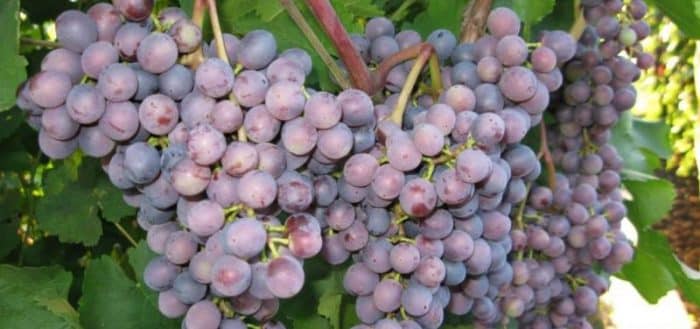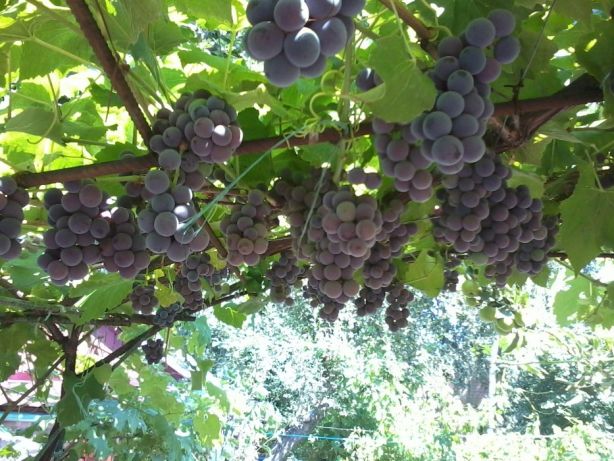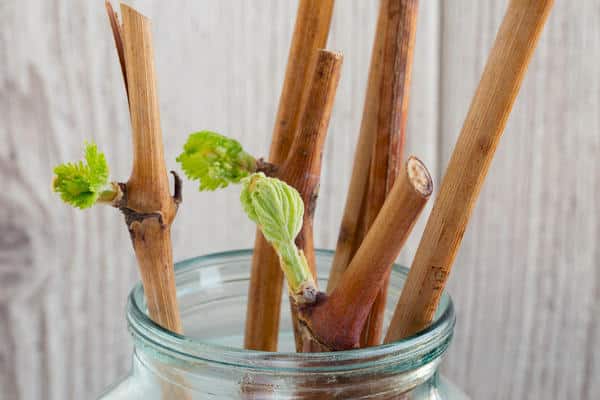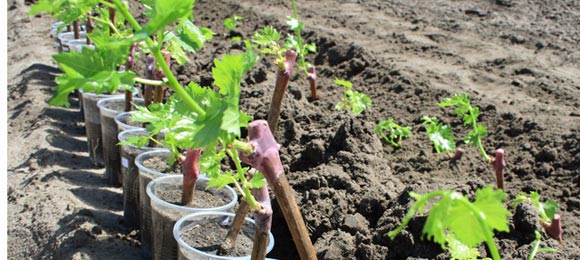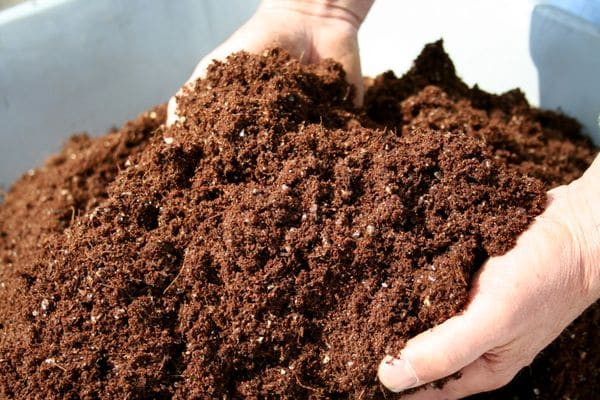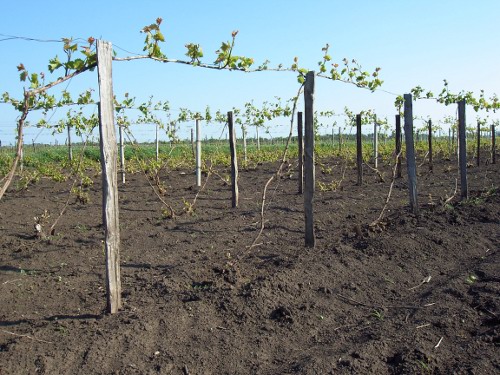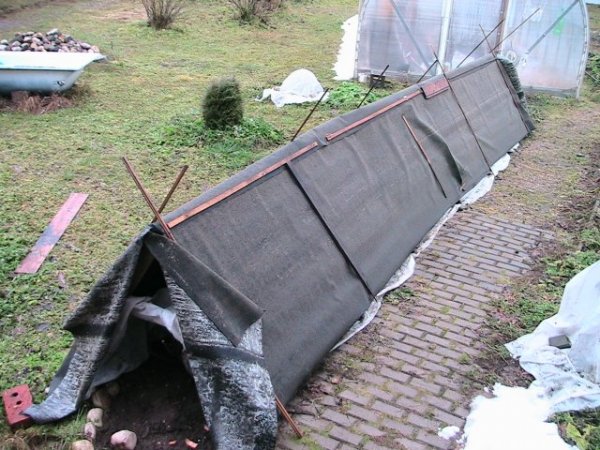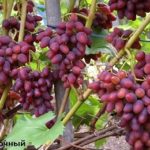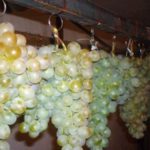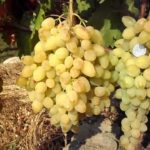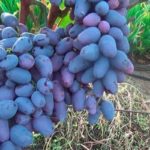Early Violet grapes have occupied a leading position in viticulture since the middle of the last century. It is characterized by increased resistance to cold and pathogens of major diseases. The harvest is actively used to produce the highest quality wine called Muscat Steppe Rose. Growing this type of vine is extremely simple; it does not require much attention.
- History of hybrid breeding
- External characteristics of the variety
- Berries and leaves
- Acidity and calorie content of fruits
- Taste qualities
- Bush, vine and leaves
- Technological parameters
- Low temperature resistance
- Immunity to fungal infections and diseases
- In what areas can it grow?
- Reproduction methods
- Features of planting and care
- Terms and rules for planting seedlings
- Watering mode
- What and when to feed grapes
- Formation
- Garter to posts
- Seasonal prevention and treatment
- Preparing for winter
- Berry ripening period
- Harvest and use
- Possible problems during cultivation
History of hybrid breeding
The variety was developed by cross-pollination of mother plants. It was decided to take Hamburg and Northern Muscat as a basis. Scientists from the All-Russian Scientific Research Institute worked on the development. Ya. I. Potapenko, located in Novocherkassk. The grape was bred in 1947, and the application for inclusion in the State Register was submitted only 10 years later. After almost the same period of time, he was included in variety testing and was included in the selection variety achievements. Recommended for cultivation in the Lower Volga and North Caucasus regions. The climate of Kiev, as well as other areas, is suitable for cultivation, but the hybrid can no longer boast of early ripening and productivity.
External characteristics of the variety
The description of the variety indicates that Early Violet has original distinctive features by which it can be distinguished from other similar species.
Berries and leaves
The leaves of this grape are split, have a rounded shape and a rich green color. There is slight pubescence on the lower part.
Depending on the cultivation conditions, the leaves may be deformed and slightly modified.
The berries of Violet Early are small in size, the weight of one of them ranges from 2 to 6 grams. At the stage of technical ripeness, they acquire a dark purple, almost black color with a slight waxy coating of a bluish color. The pulp inside the fruit is colorless. The mass of the brush reaches 200 grams, and its length is about 17 cm.Each berry contains 2-3 seeds.
Acidity and calorie content of fruits
The taste of the Violet Early fruit is sweet and very pleasant. The acidity of this grape is low, and the calorie content is about 65 kcal per 100 grams of product.
Taste qualities
Thanks to the good balance of sugars and acids in this variety, tasters highly appreciated its taste and assigned a rating of 8.9 out of 10 possible points.
Bush, vine and leaves
The old vine of the Violet Early Grape is brown in color. It is quite powerful, and the bush itself is tall. The leaves are small, five-lobed, round in shape. It is extremely rare to find whole sheets, the edges of which are slightly curved downwards. The flowers of the grapes are bisexual, so there is no need to plant pollinating varieties nearby.
Technological parameters
The technological characteristics of Violet Early make it stand out from the crowd and give an idea of the main advantages and disadvantages of the variety.
Low temperature resistance
Early violet is able to withstand temperatures down to -27 °C in winter, however, experienced winegrowers still recommend growing it in a covered form to prevent the branches from icing up.
Immunity to fungal infections and diseases
This variety demonstrates increased resistance to the main types of diseases and the negative effects of pests, in particular to leaf rollers and gray rot. Also, the crop is not damaged by wasps, but birds can spoil it, which is why the mandatory installation of repellent mechanisms is required.
In what areas can it grow?
The best yield and quality of fruits are obtained when growing Early Violet in the Lower Volga and North Caucasus regions, but the grapes are successfully cultivated throughout the country and even far beyond its borders. It adapts to the harsh climate of the north and the heat of the south.
Reproduction methods
This variety can be propagated by all known and available methods, but experienced winegrowers prefer to do this by layering or rooting petioles. At the same time, the characteristics of the mother plant are best transmitted to the daughter bushes. They also often make a graft, which takes root quickly and well.
Features of planting and care
Even such an unpretentious variety as Early Violet needs care and proper care. Otherwise, the quality and quantity of the harvest is noticeably reduced.
Terms and rules for planting seedlings
Young Violet early grape vines are planted from May to October. Timing may vary depending on region and climatic conditions. The distance between bushes is left at least 1.5 meters. The depth of the planting hole is about 35 cm. Near the vineyards there should be no tall trees, buildings or other structures that significantly shade the area.
Watering mode
Watering grapes Purple early is carried out as needed if the weather is hot and dry outside. The plant does not like excess moisture in the soil. It is recommended to apply no more than 70 liters of water to each bush. Irrigation is stopped completely when the fruits begin to ripen and color.
What and when to feed grapes
In the first 2-3 years after planting the vine on the site, it is not necessary to feed it. In the subsequent period in the fall, compost or humus, as well as 250 g of wood ash, are added under the bush.At the moment of ovary formation, the grape bushes are topped with fermented mullein solution. During the growing season, it is advisable to carry out several foliar feedings by spraying the vineyard with liquid fertilizer.
Formation
Violet early bushes begin to form from the second year of life. First, the vine is pruned into 2 buds, the next season already into 4. If the plant is planned to be covered, then the molding is carried out in 4 sleeves, and when grown without covering - in 2 sleeves. The standard is left 1.2 meters high. Each sleeve should contain no more than 7 eyes, and no more than a couple of bunches should be left on one shoot.
Garter to posts
In the first year after planting, it is necessary to tie the young vine to high posts, and then build for garter grapes trellises or install T-shaped posts on which sleeves with shoots hanging down will be attached.
Seasonal prevention and treatment
Despite the fact that Violet Early demonstrates very good resistance to common diseases, preventive treatments are necessary. They are made only a couple of times during the entire growing season: in spring and autumn. For these purposes, copper-containing preparations or Bordeaux mixture are used.
Preparing for winter
Early purple demonstrates record frost resistance, however, experienced gardeners recommend covering it for the winter, especially when grown in a southern climate. This is done to prevent icing of the vine. As a last resort, it should at least be removed from the trellis, bent to the ground and sprinkled with loose soil.
Berry ripening period
Early Violet grapes ripen on average 130 days after flowering, but this period is highly dependent on weather conditions. The fruits ripen around the beginning of September, but to make wine they are allowed to sit on the bushes for another couple of weeks.
Harvest and use
Dry and sunny weather is chosen for harvesting grapes. Work is carried out during the day, when there is no dew. The fruits should be well ripened and full of sugar. The berries are used primarily for winemaking, but they can be eaten fresh, processed and prepared.
Possible problems during cultivation
The Violet early grape variety is resistant and immune to pests, but gardeners during the ripening of the harvest are often annoyed by birds who try to feast on the tasty fruits. You have to take care in advance about installing additional protective equipment and repelling birds.

